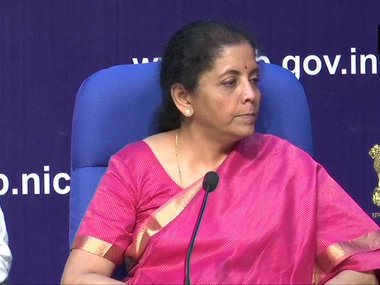That women are better at balancing the household budget than men is a truism that has been more or less accepted. There are exceptions to this, but it appears that Nirmala Sitharaman is not one of them. In her maiden budget, she is promising to keep the fiscal deficit at 3.3 percent of GDP, lower than the 3.4 percent projected in the interim Budget presented by Piyush Goyal. She has also promised that the fiscal deficit will come down to 3 percent in 2020-21 and will remain at that level in 2021-22 as well. To that extent, she deserves the applause that is coming her way for presenting a fiscally responsible Budget. It would not have been an easy choice to make—there must have been a lot of pressure to go easy on fiscal consolidation in order to get growth going once again. After that applause, a more closer look is warranted in order to (a) look at the quality of the deficit, and (b) how realistic the assumptions underlying the 3.3 percent figure are. (One caveat is necessary at this point: the actual fiscal deficit will actually be higher because successive governments have been delaying payments they were due to make in order to show better numbers. A case in point is payments to the Food Corporation of India—every year the government holds back some of the subsidy it has to pay. In 2016-17 (the last date for which figures are available, it paid only 48.8 percent of the subsidy due to FCI. There are other cases like this.) [caption id=“attachment_6941571” align=“alignleft” width=“380”]  File image of Finance Minister Nirmala Sitharaman. PTI[/caption] Quality of deficit really means a higher fiscal deficit can be condoned if more of the borrowed money is going toward capital expenditure than revenue expenditure. Simply put, money is being used for asset creation than day-to-day expenditure. One way of assessing the quality of the deficit is to look at how much of the fiscal deficit is accounted for by the revenue deficit. Seen in this light, there are some worrying signs in the deficit numbers this year. The fiscal deficit may have been brought down from 3.4 percent to 3.3 percent between the interim and full budgets, but the revenue deficit has gone up—from 2.2 percent of the GDP (in both the revised estimates of 2018-19 and the Budget estimates of the interim Budget) to 2.3 percent of GDP. Look also at the percentage of revenue deficit in the fiscal deficit—it has gone up from 64.7 percent in the 2018-19 RE to 68.9 per cent in 2019-10 BE (even in the interim Budget, the share of the revenue deficit in the fiscal deficit was 66.7 percent). What has accounted for this rise in revenue deficit (the gap between revenue receipts, estimated to grow at 13.4 percent and revenue expenditure, set to grow 14.3 percent)? The Medium Term Fiscal Policy Statement cum Fiscal Policy Strategy Statement says much of the Rs 3,07,168 crore increase in revenue expenditure between 2018-19 and 2019-20 is due to support for the agriculture sector. It is not clear right now, what form this support takes—is it higher support prices or other kind of subsidies? No doubt the agriculture sector needs a lot of support but does it not need more of support on the capital expenditure side? Growth in capital expenditure this year is estimated at 6.9 percent—half of the growth in revenue expenditure. Its share in total expenditure has also fallen—from 12.8 percent in 2018-19 RE to 12.15 percent in 2019-20 BE. Now, revenue expenditure was always the larger share of the expenditure pie, but the skew was becoming favourable towards capital expenditure since 2015-16, when its share went up to the 14 percent range. The reversal of this trend is not a good sign. How realistic are the deficit assumptions? Much of it seems predicated on growth in revenue and capital receipts. But is a 11 percent increase in tax revenue realistic at a time when the economy is faltering? And can corporate tax collections increase 14 percent after a major give away in the form of bringing 93 per cent of companies under the lower 25 percent tax rate? Capital receipts are set to grow 12.5 percent and within that disinvestment receipts are estimated to grow 31.25 percent. But unless there are some big ticket strategic sales, this number appears a bit difficult to achieve. Besides, can the government contain growth in revenue expenditure at 14.3 percent? Interest payments are still gobbling up 40 percent of tax revenue. The food subsidy bill is estimated to grow only 7.5 percent but support prices have been raised and this is bound to push up this head of expenditure, especially since the government seems reluctant to increase the retail price of subsidised foodgrain at fair price shops, which continue to be at the same rates fixed in 2014—Rs 3 a kg for rice, Rs 2 a kg for wheat and Re 1 a kg for coarse grains. The petroleum subsidy bill increase is estimated at 50 percent but how this pans out will depend on global oil prices. Sitharaman has been brave in wanting to remain on the fiscal consolidation path, but the challenges are significant. If she pulls it off, without the sleight of hand that finance ministers usually do, she will deserve more than the kudos she is currently getting. We’ll have to wait till February to know. (The writer is a senior journalist and author. She tweets at @soorpanakha)
Nirmala Sitharaman is promising to keep the fiscal deficit at 3.3% of GDP, lower than the 3.4% projected in the interim Budget presented by Piyush Goyal
Advertisement
End of Article


)
)
)
)
)
)
)
)
)



